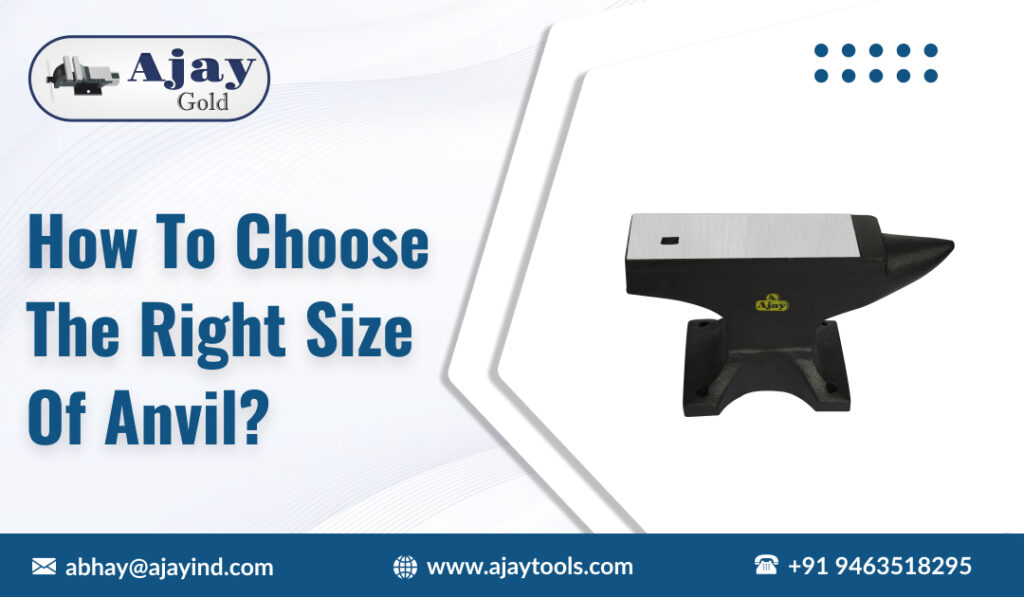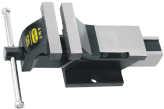One of the oldest metalworking tools is an anvil which has been used by people for many years. Over time, the tool has undergone a number of changes. These anvils are usually manufactured using cast iron. These tools are widely available across the inventories of numerous companies. However, Ajay Tools stands out for the exceptional quality of its products. The company’s primary goal is to offer high-quality metalworking tools and equipment to its customers. We offer anvils of different sizes to meet customer requirements. Curious about what they are and the benefits of using them? Keep reading to find out more.
What are the different components of an anvil?
The following are the main components of an anvil:
- Face: The flat upper surface where the majority of the work is carried out.
- Horn: The horn is used for bending and shaping metal.
- Step: A small, flat section between the face and horn, typically used for cutting.
- Hardie Hole: A square hole is designed to hold hardy tools (such as chisels or cutting tools).
- Pritchel Hole: A round hole, which is used for bending and punching rods. This hole is especially beneficial for tasks like creating bolt holes or other openings in metal pieces, offering a convenient method to enhance the functionality of metal components.
What to consider when choosing an anvil?
To choose the right size of an anvil, you need to consider the type of work you will be performing using an anvil, the weight of a hammer you will use, and the size of an anvil that you can easily manage:
- You need to check the type of work you are looking to perform using an anvil. For delicate work, you can choose a smaller size of an anvil, on the other hand, if you are working on larger forging projects, you need to choose large anvils.
- Your anvil should be heavier and can endure hammer strikes.
- If your anvil needs to be moved more often, then you can choose a light weight anvil.
What is the role of an anvil?
Anvils provide a solid and long-lasting surface for hammering and shaping metal. Their robust construction absorbs the force of hammer blows, enabling the metalworker to shape and refine the metal. The flat face of the anvil offers a smooth area for general forging, while the horn and various holes add versatility for more specialized tasks. Common tasks performed on an anvil include:
- Shaping Metal: Metalworkers use the anvil horn to bend and curve metal. Its tapered, conical shape is suitable for creating rounded forms and angles, allowing for controlled and smooth bends. This is specifically useful for creating curved shapes. By heating the metal to increase its flexibility, the worker can manipulate it with precision to achieve the desired form.
- Flattening metal: The flat surface of the anvil is used to flatten metal pieces. Hammering the metal on this smooth, solid surface helps eliminate imperfections, achieve consistent thickness, and ensure level and even shape. This process is crucial when preparing metal for further joining or shaping, as a flat surface is crucial for accurate assembly and fitting.
- Cutting metal: The hardy holes on the anvil can hold several cutting tools, such as hardy cutters. Metalworkers place the metal over the cutter, which is anchored securely in the hardy hole, and strike it with a hammer to make precise and clean cuts. This technique is essential for cutting metal to specific lengths or shapes needed for various projects. We are not only known for manufacturing anvils, but we also manufacture drill press vices, bench vices, machine vices, lubricating equipment, woodworking vices, table vices, and clamps.
- Punching Holes: The pritchel hole in the anvil is used for punching holes in metal. A punch tool, known as a pritchel, is placed over the hole, and the metalworker strikes it with a hammer to create precise openings. This method is especially useful for creating bolt holes, rivet holes, or other necessary perforations in metal pieces.
Conclusion
Anvils are crucial tools used in metalworking, offering solid and smooth surfaces for forming and shaping metals. To choose the right size of the anvil, you need to pay attention to many things mentioned above. To choose the suitable size of an anvil, you can shop at Ajay Tools.


